Introduction
Economics Behind Everyday Decisions explores how fundamental economic principles influence the choices we make in our daily lives, from personal spending and time management to broader societal issues. It examines how scarcity, opportunity costs, and rational decision-making affect individual behavior and interactions within the larger economy.in this article, we explain the scarcity and opportunity cost, behavioral economics, consumption decisions.
Scarcity and Opportunity Cost:
Scarcity
Scarcity means that resources—time, money, energy, etc. are limited. Because we can’t have everything, we must make choices.
Scarcity exists because our desires for goods and services are greater than the available resources to produce them.
It forces individuals, businesses, and governments to make choices about how to allocate resources.
Scarcity applies to all resources, including time, money, natural resources, and labor.
Opportunity Cost
The opportunity cost of a decision is the value of the next best alternative that you give up when you choose something.
Opportunity cost is the value of the next best alternative that is given up when a choice is made.
It represents the potential benefits that are lost when one option is chosen over another.
Every decision involves an opportunity cost, whether it’s a personal choice or a business decision.
Behavioral Economics
Challenging Rationality:
Behavioral economics questions the idea that people always make optimal decisions in their own best interest. It acknowledges that individuals are influenced by cognitive biases, emotions, and social norms.
Psychological Principles:
It incorporates insights from psychology, such as prospect theory, which explains how people frame choices and experience losses and gains differently.
Bounded Rationality:
This concept, developed by Herbert Simon, suggests that individuals make decisions based on limited information and cognitive abilities, often settling for “satisficing” (good enough) rather than optimal outcomes.
Heuristics and Biases:
People use mental shortcuts (heuristics) to simplify decision-making, which can lead to systematic biases and errors.
Social and Emotional Influences:
Behavioral economics recognizes that social norms, peer pressure, and emotional states can significantly impact economic choices.
Present bias: Choosing short-term pleasure over long-term benefit (e.g., binge-watching vs. preparing for a job interview).
Loss aversion: Feeling losses more intensely than gains of the same size (e.g., avoiding investing because of fear of losing money).
Anchoring: Being influenced by the first number you see (e.g., paying more for something because it was “on sale” from an inflated price).
Consumption Decisions:
1.The Decision-Making Process:
Problem Recognition:
Consumers identify a need or want that can be satisfied by a product or service.
Information Search:
Consumers gather information about potential solutions, including product features, prices, and availability.
Evaluation of Alternatives:
Consumers compare different options based on their needs, preferences, and budget.
Purchase Decision:
Consumers make the final choice and proceed with the purchase.
Post-Purchase Evaluation:
Consumers reflect on their satisfaction with the purchase and its effectiveness in addressing their initial need.
- Economic Perspectives:
Rational Choice Theory:
This theory assumes consumers make logical choices to maximize their satisfaction (utility) given their budget limitations.
Utility:
Represents the satisfaction or pleasure a consumer derives from consuming a good or service.
Budget Constraint:
The limit on what a consumer can afford to purchase, based on their income and prices of goods.
- Factors Influencing Consumption Decisions:
Income:
Higher income generally leads to increased consumption, while lower income may restrict choices.
Preferences:
Individual tastes and preferences play a significant role in what consumers choose to buy.
The cost of goods and services directly impacts purchasing decisions. Consumers often look for value and may delay or forgo purchases if prices are too high.
Social and Cultural Factors:
Cultural norms, social trends, and peer influence can also affect consumption patterns.
Availability of Goods and Services:
The accessibility and variety of options influence consumer choices.
Expectations:
Anticipated future changes in income, prices, or availability of goods can also impact current consumption.
- Short-Run vs. Long-Run Decisions:
Short-Run:
Consumption decisions made within a limited time frame, constrained by existing assets and commitments. Consumers may not be able to adjust their behavior significantly in the short term.
Long-Run:
Decisions made with a longer time horizon, allowing for more significant adjustments to consumption patterns and lifestyles.
- Routine/Habitual: Automatic purchases of frequently bought items with minimal thought.
Limited: Consumers spend some time researching and comparing options, especially for moderately priced items.
Extended: Extensive research, evaluation, and consideration are involved when making significant purchases, like cars or homes.
Conclusion
The economics behind everyday decisions helps us make more informed, rational, and impactful choices. Whether we’re spending money, using time, or planning for the future, we’re constantly weighing trade-offs. By applying economic thinking, especially understanding opportunity costs, incentives, and marginal analysis, we can navigate daily life with greater clarity and confidence.
READ: Micro vs. Macro Economics


